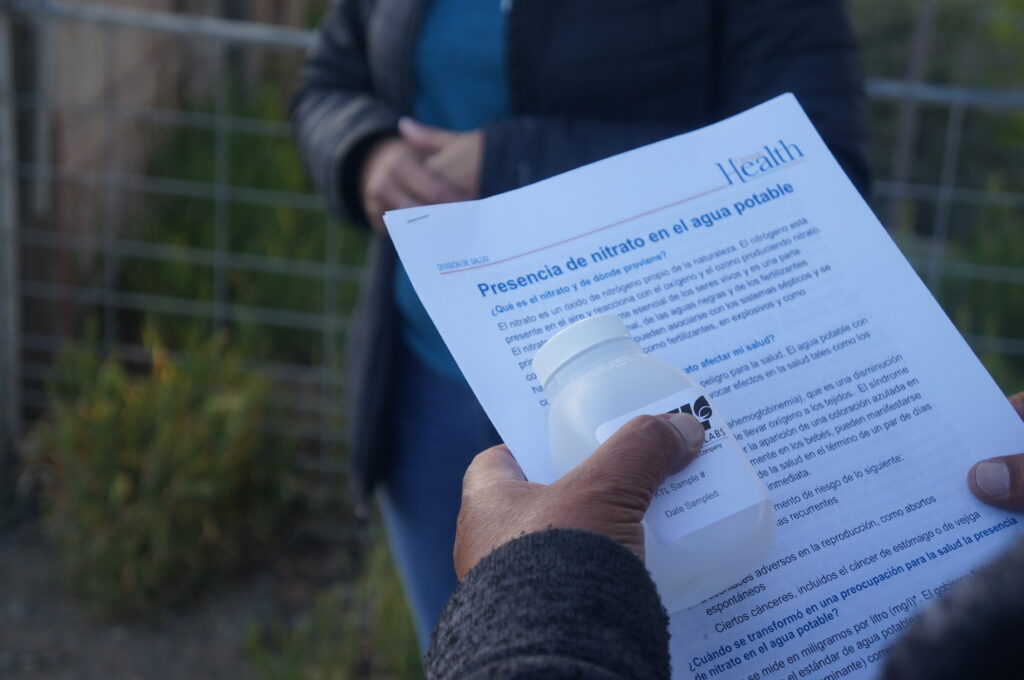A resident in the West Glen neighborhood in Boardman receives information about nitrate contamination from the local public health department in the spring of 2022. (Alex Baumhardt/Oregon Capital Chronicle)
This story will be updated with perspectives from residents and organizations in Morrow and Umatilla counties.
Oregon officials have released a comprehensive plan for curbing years of water pollution in northeast Oregon that “will take decades” to achieve.
On Friday, Gov. Tina Kotek’s office released a 153-page, cross-agency plan for reducing nitrate contamination in the aquifer supplying drinking water to thousands of people in Morrow and Umatilla counties. A Spanish-language version will soon be available, according to Anca Matica, a Kotek spokesperson.
Kotek’s goal, along with the Oregon Department of Environmental Quality, the Oregon Department of Agriculture, the Oregon Health Authority and the Oregon Water Resources Department, is to reduce nitrate contamination in the aquifer, getting it to a safe level, based on U.S. Environmental Protection Agency standards. To do this, each agency proposed a slate of new actions to closely monitor and regulate the sources of the pollution.
For more than 30 years, the state has known that the water has been continually contaminated by farms and livestock operations along with the spread of wastewater from area food processors and the Port of Morrow onto farm fields, contributing to high levels of nitrate contamination in the aquifer. Nitrates are found in fertilizers, manures and food processing wastewater and are unsafe to drink over long periods at levels exceeding 7 parts per liter. The residents most at risk of nitrate contamination in the area draw water directly from the aquifer through wells, and they are disproportionately low-income and Latino.
“This is a complex problem with no easy solutions – and it will take collaboration amongst all players to see meaningful change in the basin. The state is committed to this ongoing work,” Kotek said in a news release.
The plan comes two years after an investigation by the Capital Chronicle revealed the predicament of people whose wells have been drawing tainted water while the state did little to help. Local officials sought help from state officials for months, and it was only last year that the Oregon Health Authority got involved in testing the tap water of domestic well users. But it’s only tested half of about 3,300 wells, and critics say Kotek’s administration needs to do more to protect people’s health.
The government’s latest plan attempts to add some regulatory teeth to what has been decades of voluntary recommendations extended to area polluters without any enforcement mechanism. Still, many of the proposed changes in manure and fertilizer management will be voluntary. The state will produce an annual progress report, presumably until the contamination has been curbed, according to the release. Some actions have already begun or are beginning this year, and will be ongoing for at least the next three to four years, according to the plan.
State agencies face limitations in regulating agricultural contamination because farmers are exempted from many water pollution regulations in the federal Clean Water Act. Nevertheless, the Capital Chronicle found that state regulators had failed to enforce penalties on the few entities they can regulate, such as the Port of Morrow. The investigation found the port violated its wastewater permit for more than 15 years, allowing hundreds of tons of excess nitrates to be spread via wastewater across area fields and into groundwater while the Environmental Quality Department essentially did little to stop it.
Powerful port pollutes water for years with little state action
And the port has continued to violate its permit since then.
The plan proposes two ways to ensure that residents with wells have access to safe drinking water. It says state agencies will seek federal funding to help pay for extending pipes from existing city and county public drinking water systems to those households or to create a new public drinking water system to serve them.
Other long term collaborators on the Nitrate Reduction Plan include the U.S. Environmental Protection Agency, the Confederated Tribes of the Umatilla Indian Reservation, county commissions and local public health agencies in Morrow and Umatilla counties.
Casey Sixkiller, regional head of the EPA, said in the release that the federal agency will continue to monitor the state’s progress.
“Governor Kotek committed to developing a state-led approach that in the near term delivers safe drinking water to residents and in the longer term works to reduce nitrate contamination in the region’s groundwater,” he said. “EPA looks forward to continuing to work very closely with the state as they begin to implement and continue to build upon this approach.”
Officials emphasized that the pollution is not just happening in Oregon but in many parts of the U.S., and that in the northeast corner of the state, it stems from a number of different sources and has accumulated over many years. They said the most feasible way to address the contamination is to stop it in the first place.
A 2011 study to identify those sources estimated that about 70% of contamination was from agriculture, about 13% from manure at large dairy and confined cattle operations, about 8% from manure on animals out to pasture and about 5% from wastewater from food processing facilities, with about 5% from residential septic systems and other sources.
That study hasn’t been updated in more than a decade, but a new analysis should be published sometime this year, according to Antony Vorobyov, a spokesperson for the Department of Environmental Quality.
GET THE MORNING HEADLINES DELIVERED TO YOUR INBOX

